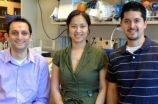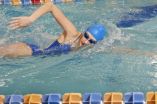(Press-News.org) Cambridge, Mass. – July 30, 2012 – Biofilms may no longer have any solid ground upon which to stand.
A team of Harvard scientists has developed a slick way to prevent the troublesome bacterial communities from ever forming on a surface. Biofilms stick to just about everything, from copper pipes to steel ship hulls to glass catheters. The slimy coatings are more than just a nuisance, resulting in decreased energy efficiency, contamination of water and food supplies, and—especially in medical settings—persistent infections. Even cavities in teeth are the unwelcome result of bacterial colonies.
In a study published in the Proceedings of the National Academy of Sciences (PNAS), lead coauthors Joanna Aizenberg, Alexander Epstein, and Tak-Sing Wong coated solid surfaces with an immobilized liquid film to trick the bacteria into thinking they had nowhere to attach and grow.
"People have tried all sorts of things to deter biofilm build-up—textured surfaces, chemical coatings, and antibiotics, for example," says Aizenberg, Amy Smith Berylson Professor of Materials Science at the Harvard School of Engineering and Applied Sciences (SEAS) and a Core Faculty Member at the Wyss Institute for Biologically Inspired Engineering at Harvard. "In all those cases, the solutions are short-lived at best. The surface treatments wear off, become covered with dirt, or the bacteria even deposit their own coatings on top of the coating intended to prevent them. In the end, bacteria manage to settle and grow on just about any solid surface we can come up with."
Taking a completely different approach, the researchers used their recently developed technology, dubbed SLIPS (Slippery-Liquid-Infused Porous Surfaces) to effectively create a hybrid surface that is smooth and slippery due to the liquid layer that is immobilized on it.
First described in the September 22, 2011, issue of the journal Nature, the super-slippery surfaces have been shown to repel both water- and oil-based liquids and even prevent ice or frost from forming.
"By creating a liquid-infused structured surface, we deprive bacteria of the static interface they need to get a grip and grow together into biofilms," says Epstein, a recent Ph.D. graduate who worked in Aizenberg's lab at the time of the study.
"In essence, we turned a once bacteria-friendly solid surface into a liquid one. As a result, biofilms cannot cling to the material, and even if they do form, they easily 'slip' off under mild flow conditions," adds Wong, a researcher at SEAS and a Croucher Foundation Postdoctoral Fellow at the Wyss Institute.
Aizenberg and her collaborators reported that SLIPS reduced by 96% the formation of three of the most notorious, disease-causing biofilms—Pseudomonas aeruginosa, Escherichia coli, and Staphylococcus aureus—over a 7-day period.
The technology works in both a static environment and under flow, or natural conditions, making it ideally suited for coating implanted medical devices that interact with bodily fluids. The coated surfaces can also combat bacterial growth in environments with extreme pH levels, intense ultraviolet light, and high salinity.
SLIPS is also nontoxic, readily scalable, and—most importantly—self-cleaning, needing nothing more than gravity or a gentle flow of liquid to stay unsoiled. As previously demonstrated with a wide variety of liquids and solids, including blood, oil, and ice, everything seems to slip off surfaces treated with the technology.
To date, this may be the first successful test of a nontoxic synthetic surface that can almost completely prevent the formation of biofilms over an extended period of time. The approach may find application in medical, industrial, and consumer products and settings.
In future studies, the researchers aim to better understand the mechanisms involved in preventing biofilms. In particular, they are interested in whether any bacteria transiently attach to the interface and then slip off, if they just float above the surface, or if any individuals can remain loosely attached.
"Biofilms have been amazing at outsmarting us. And even when we can attack them, we often make the situation worse with toxins or chemicals. With some very cool, nature-inspired design tricks we are excited about the possibility that biofilms may have finally met their match," concludes Aizenberg.
INFORMATION:
Aizenberg and Epstein's coauthors included Rebecca A. Belisle, research fellow at SEAS, and Emily Marie Boggs '13, an undergraduate biomedical engineering concentrator at Harvard College. The authors acknowledge support from the Department of Defense Office of Naval Research; the Croucher Foundation; and the Wyss Institute for Biologically Inspired Engineering at Harvard University.
New coating evicts biofilms for good
Slippery technology shown to prevent more than 99 percent of harmful bacterial slime from forming on surfaces
2012-07-31
ELSE PRESS RELEASES FROM THIS DATE:
Infection warning system in cells contains targets for antiviral and vaccine strategies
2012-07-31
Two new targets have been discovered for antiviral therapies and vaccines strategies that could enhance the body's defenses against such infectious diseases as West Nile and hepatitis C. The targets are within the infection warning system inside living cells.
No vaccines exist for the viruses that cause West Nile or hepatitis C. New therapies are urgently needed to prevent and treat serious infections by these and related viruses.
The University of Washington is engaged in a major, multipronged effort to design therapeutics that harness the warning signals the body ...
Research team discovers eating habits of Jurassic age dinosaur
2012-07-31
COLUMBIA, Mo. – A team of researchers from the University of Bristol, Natural History Museum of London, the University of Missouri and Ohio University has discovered the eating habits of Diplodocus using a three-dimensional model of the dinosaur's skull. The eating habits of the herbivore have been uncertain since its discovery more than 130 years ago. Understanding these behaviors could help scientists better understand extinct and modern ecosystems and what it takes to feed these giant herbivores, as well as today's living animals.
Diplodocus was a giant, herbivorous ...
Liver cancer cells stop making glucose as they become cancerous
2012-07-31
COLUMBUS, Ohio – As liver cancer develops, tumor cells lose the ability to produce and release glucose into the bloodstream, a key function of healthy liver cells for maintaining needed blood-sugar levels.
The findings come from a study by scientists at The Ohio State Comprehensive Cancer Center – Arthur G. James Cancer Hospital and Richard J. Solove Research Institute (OSUCCC – James).
The loss of this type of glucose production, a process called gluconeogenesis, is caused by the over-expression of a molecule called microRNA-23a. The change might aid cancer-cell growth ...
ACP and SGIM find the PCMH model aligns with principles of medical ethics and professionalism
2012-07-31
PHILADELPHIA, July 30, 2012 -- The American College of Physicians (ACP) and the Society of General Internal Medicine (SGIM) explore the ethical dimensions of the patient-centered medical home (PCMH) in a new position paper published by the Journal of General Internal Medicine: "The Patient-Centered Medical Home: An Ethical Analysis of Principles and Practice." The text is also available on ACP's website (http://www.acponline.org/running_practice/ethics/issues/policy/).
"The PCMH model of care aligns well with the traditional principles of medical ethics and professionalism, ...
Grin and bear it -- smiling facilitates stress recovery
2012-07-31
Just grin and bear it! At some point, we have all probably heard or thought something like this when facing a tough situation. But is there any truth to this piece of advice? Feeling good usually makes us smile, but does it work the other way around? Can smiling actually make us feel better?
In a study forthcoming in Psychological Science, a journal of the Association for Psychological Science, psychological scientists Tara Kraft and Sarah Pressman of the University of Kansas investigate the potential benefits of smiling by looking at how different types of smiling, and ...
Researchers identify link between kidney removal and erectile dysfunction
2012-07-31
Researchers at the University of California, San Diego School of Medicine have identified a link between patients who undergo total nephrectomy - complete kidney removal - and erectile dysfunction. Results from the multi-center study were recently published online in the British Journal of Urology International.
"This is the first study in medical literature to suggest that surgery for kidney removal can negatively impact erectile function while partial kidney removal can protect sexual function," said Ithaar Derweesh, MD, senior author, associate professor of surgery, ...
Olympic star power squandered
2012-07-31
Your best chance to see a female athlete endorsing a product will be during the next few weeks. The Olympics' commercial breaks may be littered with female swimmers, runners and gymnasts, but don't expect to see them much again until the next Olympics. American companies rarely employ female athletes as spokespeople and when they do, according to two University of Delaware professors, they most often do it poorly.
John Antil and Matthew Robinson's upcoming article in the Journal of Brand Strategy suggests advertisers' tactics are creating a cycle of failure for female ...
1 in 5 streams damaged by mine pollution in southern West Virginia
2012-07-31
DURHAM, N.C. -- Water pollution from surface coal mining has degraded more than 22 percent of streams and rivers in southern West Virginia to the point they may now qualify as impaired under state criteria, according to a new study by scientists at Duke and Baylor.
The study, published this week in the peer-reviewed journal Environmental Science & Technology, documents substantial losses in aquatic insect biodiversity and increases in salinity linked to sulfates and other pollutants in runoff from mines often located miles upstream.
"Our findings offer concrete evidence ...
Humpback whales staying in Antarctic bays later into autumn
2012-07-31
DURHAM, N.C. -- Large numbers of humpback whales are remaining in bays along the Western Antarctic Peninsula to feast on krill late into the austral autumn, long after scientists thought their annual migrations to distant breeding grounds would begin, according to a new Duke University study.
The study, published July 30 in the journal Endangered Species Research, provides the first density estimates for these whales in both open and enclosed habitats along the peninsula in late autumn.
It suggests that the little-studied bays are late-season feeding grounds for humpback ...
Parents find terms 'large' or 'gaining too much weight' less offensive than 'obese'
2012-07-31
If doctors want to develop a strong rapport with parents of overweight children, it would be best if physicians used terms like "large" or "gaining too much weight" as opposed to the term "obese." These were findings recently published by medical researchers at the University of Alberta.
Geoff Ball, a researcher in the Faculty of Medicine & Dentistry with the Department of Pediatrics, worked with department colleagues Amanda Newton and Carla Farnesi to review articles about the important relationship between families and health professionals when it comes to addressing ...
LAST 30 PRESS RELEASES:
Anxiety and insomnia may lower natural killer cell count, potentially repressing immune function
How parasitic, asexual plants evolve and live
Research spotlight: A subset of patients with depression could benefit from anti-inflammatory treatment
New fully digital design paves the way for scalable probabilistic computing
Membrane electrode assembly design for high-efficiency anion exchange membrane water electrolysis
U.S. debt ceiling disputes show measurable impact on global crude oil markets
Climate extremes triggered rare coral disease and mass mortality on the Great Barrier Reef
Direct observation reveals “two-in-one” roles of plasma turbulence
Humans rank between meerkats and beavers in monogamy ‘league table’
US fossil reveals early mass-burial event and ancient microbial attack
Sedative choice could improve outcomes for breathing tube patients
New superconducting thin film for quantum computer chips
Simulations reveal protein "dynamin" constricts cell membranes by loosening its grip
Nearly 1 in 5 UK emergency department patients cared for in corridors/waiting rooms
Heavy energy drink intake may pose serious stroke risk, doctors warn
Violence against women and children among top health threats: New global study reveals disease burden far larger than previously estimated
Predicting who is at risk of developing type 1 diabetes, as new drugs now available
New gene-mapping method unlocks hidden drivers of cancer
Ocean current and seabed shape influence warm water circulation under ice shelves
Call to increase funding for ‘invisible’ Deaf victim-survivors of domestic abuse
University of Maryland School of Medicine names distinguished scientist and academic leader Gerald M. Wilson, PhD, as Chair of the Department of Biochemistry and Molecular Biology
Receptors in mammary glands make livestock and humans inviting hosts for avian flu
Icy hot plasmas
Treating adults with autism: Maryland Clinical Center offers national blueprint for care after pediatric transition
University of Phoenix College of Doctoral Studies releases white paper on reclaiming control to build workforce resilience
NCCN Summit seeks to improve care for veterans and first responders with cancer from line-of-duty exposure
ERC Consolidator Grant for soft robotics researcher
Dual-action arts and wellbeing program transforms dementia care
The global plastic waste trade contributes to coastal litter in importing countries, study shows
UT Dallas partners with Tech Mahindra on AI innovation
[Press-News.org] New coating evicts biofilms for goodSlippery technology shown to prevent more than 99 percent of harmful bacterial slime from forming on surfaces



